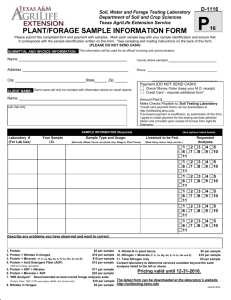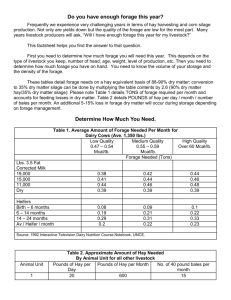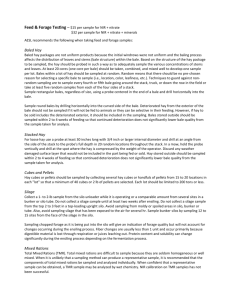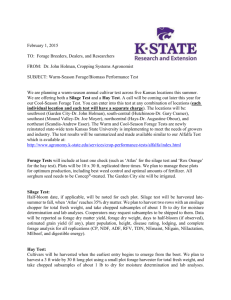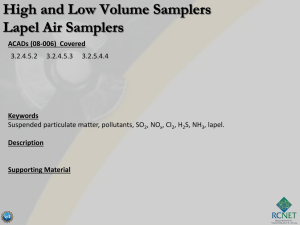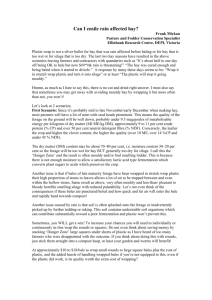Forage Sampling and Sampling Equipment AGRONOMY
advertisement
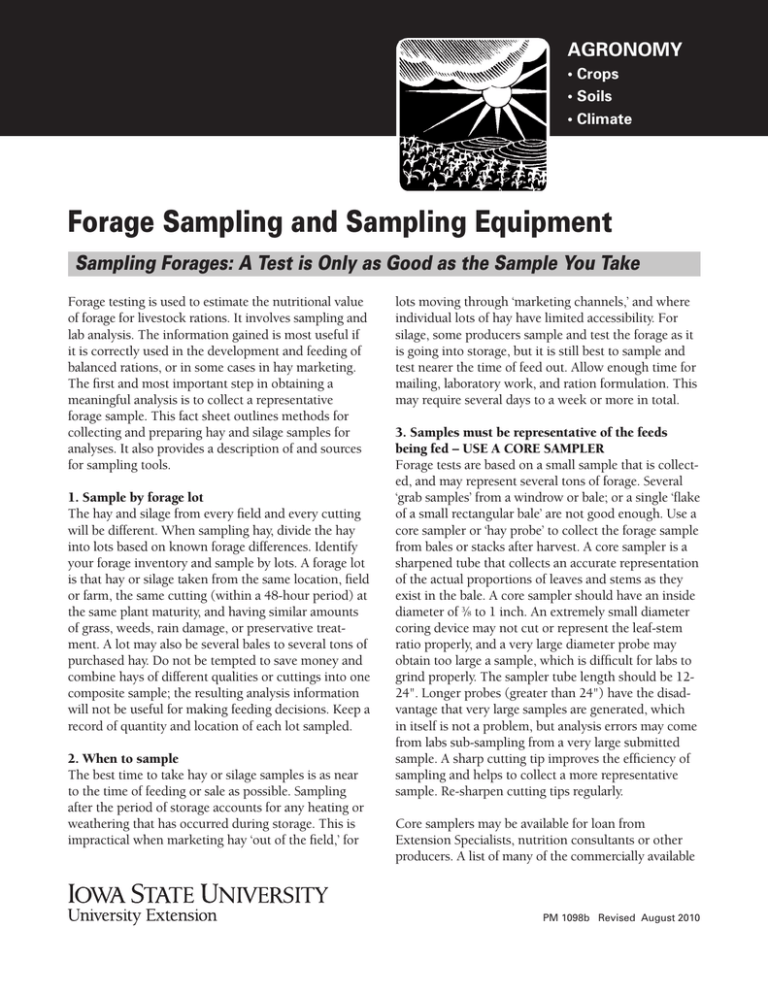
AGRONOMY • Crops • Soils • Climate Forage Sampling and Sampling Equipment Sampling Forages: A Test is Only as Good as the Sample You Take Forage testing is used to estimate the nutritional value of forage for livestock rations. It involves sampling and lab analysis. The information gained is most useful if it is correctly used in the development and feeding of balanced rations, or in some cases in hay marketing. The first and most important step in obtaining a meaningful analysis is to collect a representative forage sample. This fact sheet outlines methods for collecting and preparing hay and silage samples for analyses. It also provides a description of and sources for sampling tools. 1. Sample by forage lot The hay and silage from every field and every cutting will be different. When sampling hay, divide the hay into lots based on known forage differences. Identify your forage inventory and sample by lots. A forage lot is that hay or silage taken from the same location, field or farm, the same cutting (within a 48-hour period) at the same plant maturity, and having similar amounts of grass, weeds, rain damage, or preservative treatment. A lot may also be several bales to several tons of purchased hay. Do not be tempted to save money and combine hays of different qualities or cuttings into one composite sample; the resulting analysis information will not be useful for making feeding decisions. Keep a record of quantity and location of each lot sampled. 2. When to sample The best time to take hay or silage samples is as near to the time of feeding or sale as possible. Sampling after the period of storage accounts for any heating or weathering that has occurred during storage. This is impractical when marketing hay ‘out of the field,’ for lots moving through ‘marketing channels,’ and where individual lots of hay have limited accessibility. For silage, some producers sample and test the forage as it is going into storage, but it is still best to sample and test nearer the time of feed out. Allow enough time for mailing, laboratory work, and ration formulation. This may require several days to a week or more in total. 3. Samples must be representative of the feeds being fed – USE A CORE SAMPLER Forage tests are based on a small sample that is collected, and may represent several tons of forage. Several ‘grab samples’ from a windrow or bale; or a single ‘flake of a small rectangular bale’ are not good enough. Use a core sampler or ‘hay probe’ to collect the forage sample from bales or stacks after harvest. A core sampler is a sharpened tube that collects an accurate representation of the actual proportions of leaves and stems as they exist in the bale. A core sampler should have an inside diameter of 3⁄8 to 1 inch. An extremely small diameter coring device may not cut or represent the leaf-stem ratio properly, and a very large diameter probe may obtain too large a sample, which is difficult for labs to grind properly. The sampler tube length should be 1224". Longer probes (greater than 24") have the disadvantage that very large samples are generated, which in itself is not a problem, but analysis errors may come from labs sub-sampling from a very large submitted sample. A sharp cutting tip improves the efficiency of sampling and helps to collect a more representative sample. Re-sharpen cutting tips regularly. Core samplers may be available for loan from Extension Specialists, nutrition consultants or other producers. A list of many of the commercially available PM 1098b Revised August 2010 core samplers is provided in this bulletin. While the cost of owning your own core sampler may seem high, it is generally very economical compared to the costs of livestock production losses from incorrect rations or the feeding of unneeded supplements. 4. Sampling bales and stacks of hay To sample bales and stacks of hay, take 20 cores, one each from widely separated bales or stacks representative of the lot being sampled. Sample large and small rectangular bales by taking cores (12 to 15 inches deep) from the center of the end of the bales. Sample large round bales by taking cores (also 12 to 15 inches deep) at waist height on the rounded, tight side. If only a few large square or round bales make up the lot, take multiple cores from each bale to equal 20 cores. Sample stacks and chopped hay 18 inches deep. Avoid sampling spoiled or weathered portions of bales or stacks that will not be fed. If using a hand brace or low-powered portable electric drill, you may be tempted to collect fewer than 20 cores. Sampling error and inadequate representation of the lot variability increases if fewer than 20 cores are collected. Consider using an electric corded drill powered by a portable generator if bale storage is in a remote location. The 20 core samples from the lot should be about 1 pint to 2 quarts in volume, or about ½ pound of material, and will represent several tons of forage. Mix the collected hay cores in a clean, plastic pail. Place the entire sample (a combination of all 20 core samples) into a clean, heavyweight plastic bag. Seal the bag tightly to maintain sample moisture. 5. Sampling chopped silage crops and balage Producers have two options for sampling chopped silage crops: as it is going into storage, or at feed out. For sampling during filling, collect a representative handful or two of chopped forage from each of several loads coming from that field; place in a sealable plastic bag; squeeze out excess air; and store the samples in the freezer. For large fields harvested over several days, collect two to four handfuls of chopped forage from each of several loads during each day. Combine all the samples from the field in a sealed plastic bag and submit this large, composite sample to the laboratory, frozen. A more accurate representation of the quality of forage being fed is from silage samples taken after fermentation, at feed out. Collect grab samples at both morning and evening feeding when feeding a new silage lot. Avoid sampling spoiled silage from the top of the bunker or at the transition between lots in an upright or bunker silo. When sampling from the face of a bunker silo or from a plastic silage bag, mechanically remove the forage as it will be fed and collect grab samples from that volume. Freeze these grab samples. The accumulated grab samples (several quarts weighing 2 to 3 pounds) should be thoroughly mixed, sealed in a plastic bag, and frozen for shipment or delivery to the testing lab. For many, it seems more practical to sample during silo filling. While there are some nutritional changes during normal fermentation, nutritional changes are usually small. However, if forage is stored ‘too wet’ and the silo ‘seeps’ or it is stored ‘too dry’ and the silage heats excessively during ensiling, consider re-sampling by taking several grab samples at feed out, to account for nutritional changes during ensiling. Baled wet or wilted forage being stored as bale silage can be done either by core sampling bales before wrapping for bale silage, or sampling the wrapped bales nearer the time of feeding. If sampled plastic-wrapped bales are not being fed immediately, reseal quickly to prevent unnecessary spoilage. 6. Keep good records Record on the bag in permanent marker, name, date the crop was harvested, date sampled, and an identifier code, or number for the lot, so that when the test results come back, the proper lot can be identified. This lot identification should match your record of where the lots are located. It is also a good practice to write a brief description of the type of forage included in the sample; for example, ‘alfalfa hay,’ ‘mixed clover (70%) orchardgrass (30%) hay,’ ‘rye silage,’ etc. Some laboratories use this information in the analysis procedures. Keep a record of similar information for your own future reference, as well as information about rain or insect damage, preservative used, etc. that would be useful to you or the livestock producer when interpreting the analysis. 7. Ship samples immediately Hay and silage samples are perishable! Ship or deliver samples to the laboratory as soon as possible to prevent moisture loss and microbial deterioration of the sample. See Iowa State University Extension publication PM 1098a, Forage Testing Laboratories, for a list of commercial forage testing laboratories near you. Types and Sources of Forage Sampling Equipment Below are names, addresses, and descriptions of many of the hay sampling probes available. Prices stated are those of July 2010; contact supplier for current price. This list is not intended to be exhaustive, and is not an endorsement of these probes or a disparagement of other probes by omission. Several probes listed may have features which may tend to misrepresent samples. ‘Homemade’ Homemade core samplers have been made from golf club shafts, ski poles, soil probes, steel tubing, or conduit, sharpened on one end. Some producers modify them with handles to improve leverage, or to accommodate a hand brace or electric drill. Some producers adapt a canister to their homemade samplers for taking multiple samples. It is difficult to maintain a sharp edge on some materials. Commercially Available Core Samplers Sierra Hay Probe. Sierra Testing Service, 9450 E. Collier Road, Acampo, CA 95220. (209) 333-3337, http://www.sierratestingservice.com. A golf club-type probe with a tube ‘T’ handle and a 16.5" stainless steel golf club shaft that cuts a 0.5" core. Design allows continuous sampling of baled hay. The clean out rod provided helps protect the cutting edge during transport and storage. Price: $45 (plus shipping and handling). ‘Penn State’ Forage Probe sold by NASCO-Ft. Atkinson, 901 Janesville Avenue, Box 901, Fort Atkinson, WI, 53538-0901. (800) 558-9595, http://www.enasco.com. Stainless steel probe 18" long with replaceable serrated cutting tip that cuts 0.75" diameter cores. Probe must be emptied after each core (depress a button to remove probe and extract the sample). Unit shipped with adaptor for use with electric drill, $114.25 (plus shipping). Oakfield Sampler. Oakfield Apparatus, Inc. P.O. Box 65, Oakfield, WI 53065. (920) 583-4114, http://www.soilsamplers.com/safety_sampler.html. Single core sampler with serrated cutting tip. Sold with adapter for hand brace. Sampler, brace adaptor, cutting tip and dowel rod $218.25 plus shipping and handling. Adaptor for ½" drill $24 additional. Colorado Hay Probe. UDY Corp., 201 Rome Court, Ft. Collins, CO, 80524. (970) 482-2060, http://www.udyone.com/hayprobeinfo.htm. Several types available. Push-in type, multiple-core sampler, 5 ⁄8" by 18" tube, aluminum or PVC canister (price varies with tip and canister type), $182-$216. Drill-type, single core; 0.75" by 18" $172; Drill-drive, multiple-core type with 5⁄8" by 18" tube, $277. Shipping and handling not included. All parts are replaceable and are available. Frontier Mills Sampler Frontier Mills, Inc., 2002 So. Dak. Highway 314, Yankton, SD, 57078. (800) 995-2441. Multiple core, canister-type sampler, has 30" core tube with replaceable cutting tip. Spiral screw on tube to aid in bale penetration. For hand brace use. Price; $156.23 (includes shipping and handling). Star Quality Samplers Star Quality Samplers, 5719 114A Street, Edmonton, AB Canada T6H 3M8. (780) 434-3367. Web: www.starqualitysamplers.com. Several types available. A one-at-a-time, push-in corer (‘UniForage’ Sampler) has a ‘T’ handle, $185, or is optionally drill-driven (with spiral assist), for $215. Push in, multiple core, canister type (‘MultiForage’ Sampler) comes in several configurations costing from $120 to $205. Drill-driven, canister-type (with spiral assist) is priced at $365. Shipping and handling is additional. Contact them for prices for various replacement parts and cutting tips. HMC Hay Probe Hart Machine Co., 1216 SW Hart Street, Madras, OR, 97741. (541) 475-3107. Multiple-core, canister-type core sampler; has 12" core tube with hardened, smooth cutting tip; can be used with hand brace or electric drill. Price $335 (including shipping). Longer tube samplers are available: 18", $350; 24", $365; and 30", $280. Aluminum plunger is $25 additional. Hay Chec Hay Sampler Hodge Products, Inc., PO Box 1326, El Cajon, CA, 92022. (800) 854-3565, http://www.hpionline.com. A “push-type” sampler. This is a 12" long hand probe with an internal diameter of (7⁄16") with a stainless steel body and a clear plastic catch sample collection jar, and a sample clearing stick. Price $350, plus shipping. AMS hay and forage probes AMS, Inc., 105 Harrison St., American Falls, ID 83211. (800) 635-7330, http://www.ams-samplers.com. These are ½" drill-adaptable probes with a 7⁄8" outside diameter tube, serrated cutting tip, and wood dowel. It can be ordered with either a 12" or 24" probe tube. It can be purchased as a single sample probe $195-$240; or as a multiple-core sampler with a plastic canister capable of holding approximately 20 cores; $285-$325. Replacement parts available. Shipping and handling additional. Best Harvest Hay Sampler Best Harvest Inc. Glendale, AZ 85304. (888) 947-6226, http://bestharveststore.com. Available in: multi-core, push type sampler with serrated tip and 5⁄8" x 18" tube; $189; drill-type, multi-core sampler with 5⁄8" x 18" tube $179.00; drill-type, multi-core sampler with 5⁄8" x 24" tube $219; or a drill-type, multi-core sampler with 5⁄8" x custom-length tube. Samplers come with clean-out rod. Replacement parts are available. Shipping and handling additional. Prepared by Stephen K. Barnhart, Extension Forage Agronomist, Iowa State University, Ames, IA. . . . and justice for all The U.S. Department of Agriculture (USDA) prohibits discrimination in all its programs and activities on the basis of race, color, national origin, gender, religion, age, disability, political beliefs, sexual orientation, and marital or family status. (Not all prohibited bases apply to all programs.) Many materials can be made available in alternative formats for ADA clients. To file a complaint of discrimination, write USDA, Office of Civil Rights, Room 326-W, Whitten Building, 14th and Independence Avenue, SW, Washington, DC 20250-9410 or call 202-720-5964. Issued in furtherance of Cooperative Extension work, Acts of May 8 and June 30, 1914, in cooperation with the U.S. Department of Agriculture. Gerald A. Miller, interim director, Cooperative Extension Service, Iowa State University of Science and Technology, Ames, Iowa.
